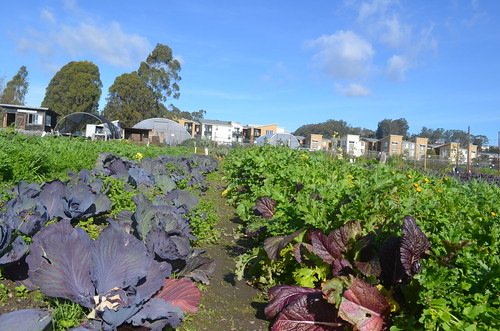
The Homeless Garden Project (HGP) in Santa Cruz, California provides sanctuary, refuge and meaningful work for homeless citizens within the healing environment of a three-acre organic farm in Santa Cruz, California. This unique urban garden and farm is inspired by the joy that comes from growing and sharing healthy food, the well-being created by vibrant social and natural ecosystems, and every individual’s potential for growth and renewal.
HGP Director Darrie Ganzhorn said, “Our vision is to create a thriving and inclusive community, workforce and local food system. Our goal is to create a world-class farm.”
Farm Manager Chris Omer gave me a tour of the garden, along with USDA NRCS District Conservationist Rich Casale and NRCS Earth Team Volunteer and University of California (UC) Santa Cruz student Ryan Hutchison.

HGP runs a Community Supported Agriculture (CSA) program, and trainees create value-added products, such as such as wreaths and candles, from farm-grown materials that are sold at a retail store downtown. People who are homeless can become trainees in the garden, where they gain transitional employment, learn basic life skills, share four hot meals a week with staff and others, and grow organic food for the local community. HGP’s Value-Added Enterprise provides work opportunities for trainees all year long, particularly during the rainy season.
Next year, the Homeless Garden Project will be growing even more as it moves to a 614-acre city-owned greenbelt site that includes a nine-acre permanent farm site. NRCS staff have been assisting with the site’s conservation plan and other natural resource issues.
“Having a permanent site provides new opportunities—for the first time, we'll be able to have orchards and create a 20-year farm plan,” said Ganzhorn.
The USDA Natural Resources Conservation Service (NRCS) provides conservation assistance for all types of agriculture–from the very large-scale production farm and ranch to small, community-based projects such as this.
Omer said, “Early on, we met with [NRCS district conservationist] Rich Casale to talk about the possibility of using the NRCS Environmental Quality Incentives Program Organic Initiative and conservation planning for the site.”
NRCS provided soils information and preliminary wetland determinations for the new site, as well as overall conservation planning assistance. “The goal is to incorporate wildlife and enhance any wetland areas, organically working with nature,” said Casale. “There are major opportunities with the new site. You want to think of water issues up front and plan for key strategies such as water harvesting and irrigation. Understanding soil and crops can help make the water go further.”
“You’ve got to keep asking the question―how can we do all of this better?” said Casale.
The farm will be organic from day one. The usual three-year period to transition to organic won’t be needed, since the land has been fallow for years.
Ganzhorn said, “From the very beginning, Homeless Garden Project has been organic. When addressing root causes of homelessness, it's always been important to us to use sustainable farming methods and to focus on long-term health and well-being in the most holistic way possible. Organic does this.”
“The garden engages citizens directly on the importance of organic practices and opens participants' eyes to possibilities for building a healthier future. Support of community gardens from USDA and NRCS brings national movements together with local citizen action to multiply results of both movements,” she said.
Both NRCS and the Homeless Garden Project benefit immensely from volunteer support.
“Last year, nearly 2,500 people volunteered in our organization, taking away experiences of organic agriculture, community building, social enterprise and a deeper understanding of how our community can address homelessness. Above all, volunteers and visitors take away a sense of agency. We all can build the kind of community we want to live in,” said Darrie.
The NRCS Santa Cruz district office regularly has NRCS Earth Team volunteers, many of whom are students at UC Santa Cruz. These Earth Team volunteers work on anything from conservation planning to soil testing. Many former Earth Team volunteers from this office have gone on to careers in agriculture and environmental fields. In addition to experience, the time as an Earth Team volunteer also provides insight into the types of careers possible for them.
Homeless Garden Project participants have transitioned from being homeless to careers in farming, restaurants, floral shops and others, and to having their own homes. The garden is life-giving in so many ways, and demonstrates that effort, care and patience can make both people and plants thrive.
It is wonderful to see NRCS, working along with so many others, provide assistance to such a worthy effort ―one that enables people, as well as plants, to grow and blossom.
For more information on NRCS, visit our website at www.nrcs.usda.gov; for information on NRCS assistance for organic agriculture, visit www.nrcs.usda.gov/organic.




